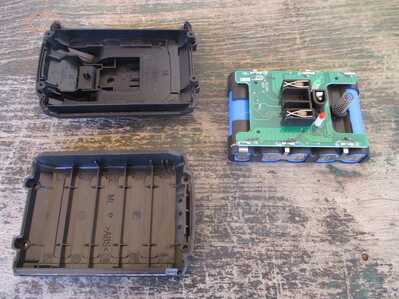Hi @robotbuilder and Ron @zander,
I think you both have the general picture now ... at least as far my limited understand, which may be flawed.
Namely, if you need fast (high current) charging capability, this is likely to use the main power connections for both charging and discharging... though of course there will always be exceptions with batteries with two pairs of high current connections for some reason or other.
The monitoring/balancing wires are usually much lower current capability, so they might be only used for voltage monitoring, or they may also play a part in the charging and discharging, especially if the BMS has a charge balancing capability. Obviously, if these wires are thin, which they typically are, then the current capacity will be limited, but even relatively thin wires, say 1 square mm, can still carry several amps. Assuming all of the cells of a battery are of identical design and 'age', then the balancing should not exceed a few per cent of the total capacity, so the current flows should be modest compared to those required of the total battery capabilty.
My understanding regarding lithium-ion battteries, which include so called Li-Po s, is that the most important provision is one of cell monitoring ... in the event of cells being over charged or discharged, the entire chemistry of the cell can change, resulting in a very dangerous device.
Balancing is used to obtain the maximum capacity performance from a set of cells whch will all naturally have slightly different capacities, in spite of being identical design. In the absence of balancing capability, the monitoring system will limit the battery to that of the weakest cell, as it is essential that no cell is over stressed.
Balancing is much more important in batteries which have cells in parallel, as well as in series.
There are two different balancing 'options' .. sometimes described as active and passive.
With the passive scheme, the higher performing cells (ie are exhibiting a slightly higher voltage) are discharged to match that of their immediate 'colleagues', so that they all work as a 'team'. My guess is this likely to be the scheme chosen for the batteries in the video.
The active scheme actually transfers charge from one cell to another as the battery is discharged, so that they are all kept at the same percentage of discharge of their individual capacities. This requires each cell to have an individual boost power supply so that it can accept the discharge voltage from another cell whch has charge to spare, and boost it to the voltage needed to charge the more depleted charge cell. This is obviously a considerable amount of electronics, although chip technology packaging can assist. Hence, I would normally expect this to be used in higher capacity batteries .... perhaps the battery pack for an electrically powered only car could be a candidate, where each cell will be much larger than the 18650s, etc. that we are generally more familiar with?
Hope this is clear, of interest and doesn't have to many errors.
Best wishes, Dave
I'm glad everyone learned something.
Strangely I was quoted, however I only repeated what was on the Video, and was asking for clarification (disagree all you want, I was just a repeating rabbit 😆 )
Looks like my Question about Wire Thickness vs Current/Voltage limits was answered. I assume I might find a table of some kind.
All modern Batteries (lithium based) have balance leads, even if you don't see them
Now in the video it was charging at 4 AMPS, but this was conservative charging Amps vs what the Battery was rated for.
I'm assuming (again) that the High Charge rate is done though the main power leads, and top-up with the Balance Cell leads, which involves a microprocessor of some kind.
This One, a long time I have I watched. All this life has he looked away to future, to the horizon. Never his Mind on where he was! what he was doing!
Yoda
@dazza Here are the two tables I use for wire size calculations.
https://www.powerstream.com/Wire_Size.htm
http://wiresizecalculator.net/calculators/advancedwiresize.htm
First computer 1959. Retired from my own computer company 2004.
Hardware - Expert in 1401, and 360, fairly knowledge in PC plus numerous MPU's and MCU's
Major Languages - Machine language, 360 Macro Assembler, Intel Assembler, PL/I and PL1, Pascal, Basic, C plus numerous job control and scripting languages.
Sure you can learn to be a programmer, it will take the same amount of time for me to learn to be a Doctor.

